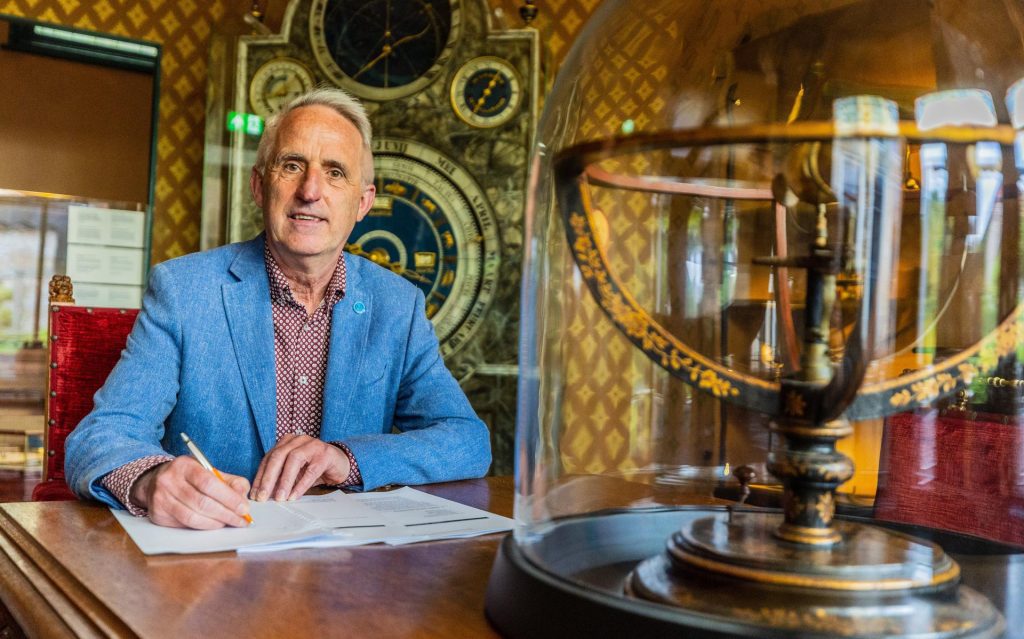Adrie Warmenhoven often clashed with his chemistry teacher. “I thought it would be a good idea to increase the tests that resulted in mild explosions by a factor of ten.” The pre-vocational secondary education exam was still very difficult.
With a piece of iron-nickel meteorite under the bell, several telescopes demonstrating the effect of light (optics) and a huge mechanical galaxy powered by gravity, Franker’s Eise Eisinga Planetarium breathes physics and chemistry, so to speak. How good is the head coach at these topics?
“I had chemistry in my group,” says Adrie Warmenhoven. “I thought it was a nice profession because it provides insight into the very complex issues that make the world the way it is. In fact, just like we do at the museum.”
Light explosions
However, this does not mean that as a teenager he always listened intently to his chemistry teacher at Petrus Canisius College in Alkmaar, the city in which he still lives. “We clashed quite often. I was a bit of a busy person and I thought it would be a good idea to increase the tests that resulted in light blasts by a factor of ten.
They met recently after all this time at a lecture given by Warmenhoven. “I liked where I ended up.”
Faded
Hard knowledge of chemistry has already greatly deteriorated. “I preferred geography and history. I wanted to understand the world around me. This is possible, of course, with different subjects, but I liked geology and archeology.”
Archeology was fascinated by dinosaurs – there is still a miniature dinosaur in his office – his first choice. “I needed French for that at the time, and I found it difficult, so I decided not to do it.”
It eventually became a geography teacher training course at Vrije Universiteit Amsterdam. After visiting the planetarium in Lucerne, Switzerland, during an Interrail trip across Europe in 1983, he was dazzled by the stars. “During my studies, I started as an educational assistant in the planetarium that was built at the Gaasperplas in Amsterdam for Floriade in 1982. After graduating I started working there full time.”
Astronomy
Fascinated by the stars, he considers it a loss that astronomy — along with mathematics, the study on which Eisinga focused — is no longer on the semester schedule. “You could still take it at HBS (ed. Hogereburgerschool, the predecessor of HAVO and VWO until 1968) and in the 1990s it was still taught as part of a wider science subject. The profession tells us a lot about our world. After all, everything around us is stardust.”
Pinas Handbook
Today’s high school student has to study physics and chemistry in addition to mathematics. How did the Warmenhoven VMBO TL/GL (also known as MAVO) test go? ,,hot. Things in the planetarium that had to do with physics and chemistry were not on the exam and it had been 47 years since I last worked on chemistry.
He mainly struggled with many formulas and equations. “This knowledge has already disappeared very far.” Students can use the binas booklet for this test, which, in addition to the formulas, also contains explanations of the symbols. “I could really use this Penas book.”
He knew one question by heart. It was about the role of oxygen in the combustion process. “But that’s common knowledge. If you have a wood-burning stove, you know that you need oxygen for good combustion, and that you can stop a fire by turning off the oxygen supply. A refresher course would have been helpful.” But the astronomy exam would have been a piece of cake ”
Final examination candidate
- Adri Warmenhofen (63)
- Occupation: Director and curator of the Eze Isinga Planetarium
- High School: Petros Canisisus College Balkmaar 1979
- Final exam: HAFU in 1979 and training for teachers of geography and social studies in 1985.
- Favorite subject: Geography and history

“Coffee buff. Twitter fanatic. Tv practitioner. Social media advocate. Pop culture ninja.”











More Stories
Which can cause an increase in nitrogen.
The Central State Real Estate Agency has no additional space to accommodate Ukrainians.
The oystercatcher, the “unlucky national bird,” is increasingly breeding on rooftops.